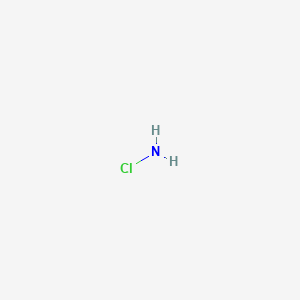

1. Ammonia Chloramine
2. Monochloramine
1. Monochloramine
2. Chloramide
3. 10599-90-3
4. Monochloroamine
5. Chloroamine
6. Monochloroammonia
7. Nh2cl
8. Kw8k411a1p
9. Monochloramide
10. Chloramine, Mono-
11. Ccris 4022
12. Chloramine (inorganic Compound)
13. Hsdb 4293
14. Einecs 234-217-9
15. Cloroamonio
16. Unii-kw8k411a1p
17. Chlorinated Water (chloramine)
18. Chloramine [hsdb]
19. Chloramine [iarc]
20. Ec 234-217-9
21. Dtxsid8023842
22. Chebi:82415
23. Dtxsid00721369
24. Pubchem_57347134
25. Amy37006
26. Akos015904329
27. 12190-75-9
28. Ft-0623594
29. C19359
30. Q409375
| Molecular Weight | 51.47 g/mol |
|---|---|
| Molecular Formula | ClH2N |
| XLogP3 | 0.1 |
| Hydrogen Bond Donor Count | 1 |
| Hydrogen Bond Acceptor Count | 1 |
| Rotatable Bond Count | 0 |
| Exact Mass | 50.9875768 g/mol |
| Monoisotopic Mass | 50.9875768 g/mol |
| Topological Polar Surface Area | 26 Ų |
| Heavy Atom Count | 2 |
| Formal Charge | 0 |
| Complexity | 2 |
| Isotope Atom Count | 0 |
| Defined Atom Stereocenter Count | 0 |
| Undefined Atom Stereocenter Count | 0 |
| Defined Bond Stereocenter Count | 0 |
| Undefined Bond Stereocenter Count | 0 |
| Covalently Bonded Unit Count | 1 |
Male Sprague-Dawley rats (220-240 g) were given 1.1 mg per animal [36Cl]-labelled chloramine [NH2 36Cl] orally as 3 mL of solution containing 370 mg/L chloramine. The peak plasma concentration of 36Cl (10.3 ug/L) was reached 8 hr after dosing, and the absorption and elimination half-lives were 2.5 hr and 38.8 hr, respectively. The distribution of radioactivity was highest in plasma and lowest in fat. Approximately 25% and 2% of the administered dose of radiolabelled chloramine was excreted in the urine and feces, respectively, during 120 hr of treatment. Only 0.35% of the administered dose of monochloramine was present in plasma as [36Cl] chloride 120 hr after treatment. No evidence for enzymatic intervention in the metabolism of monochloramine was presented.
IARC. Monographs on the Evaluation of the Carcinogenic Risk of Chemicals to Humans. Geneva: World Health Organization, International Agency for Research on Cancer, 1972-PRESENT. (Multivolume work). Available at: https://monographs.iarc.fr/ENG/Classification/index.php, p. V84 303 (2004)
The effect of 15 uM monochloramine as hepatic function was investigated in isolated perfused male Sprague-Dawley rat liver. The uptake of monochloramine averaged 98%. Approximately 0.7% of the amount taken up by the liver was reduced by glutathione (GSH) and appeared in the bile in the form of GSH disulfide.
IARC. Monographs on the Evaluation of the Carcinogenic Risk of Chemicals to Humans. Geneva: World Health Organization, International Agency for Research on Cancer, 1972-PRESENT. (Multivolume work). Available at: https://monographs.iarc.fr/ENG/Classification/index.php, p. V84 303 (2004)
Male Sprague-Dawley rats (220-240 g) were given 1.1 mg per animal [36Cl]-labelled chloramine [NH2 36Cl] orally as 3 mL of solution containing 370 mg/L chloramine. ...The absorption and elimination half-lives were 2.5 hr and 38.8 hr, respectively.
IARC. Monographs on the Evaluation of the Carcinogenic Risk of Chemicals to Humans. Geneva: World Health Organization, International Agency for Research on Cancer, 1972-PRESENT. (Multivolume work). Available at: https://monographs.iarc.fr/ENG/Classification/index.php, p. V84 303 (2004)
On dissolution of the chloramines in the epithelial lining fluid, hypochlorous acid, ammonia, and oxygen-radicals are generated, all of which act as irritants. /Chloramines/
Goldfrank, L.R. (ed). Goldfrank's Toxicologic Emergencies. 7th Edition McGraw-Hill New York, New York 2002., p. 1457